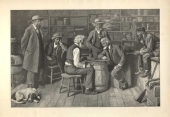The Checker Maven
The World's Most Widely Read Checkers and Draughts Publication
Bob Newell, Editor-in-Chief
Published every Saturday morning in Honolulu, Hawai`i
Noticing missing images? An explanation is here.
The Bear Trainer

Despite Brian Hinkle's generous $100 prize offer, no correct solutions were received to his admittedly difficult Bear Claw problem, and the prize offer has now expired. However, we still would like to see someone solve the problem prior to our publication of the solution, and to that end, Brian has sent us what he calls a "trainer" position.
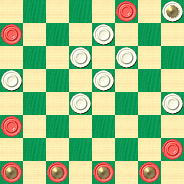
WHITE
White to Play and Draw
W:W20,18,15,13,11,10,7,K4:BK32,K31,K30,K29,28,21,5,3.
Here are Brian's comments on this position:
"There are 4 solutions to the Bear Trainer position.
- If you can find one solution then you may be a minor player.
- If you can find two solutions, then you may be a major player.
- If you can find three solutions then you may be a master player.
- And, if you can find all four solutions, then you may become the next world champion checker player!"
We can't say if Brian's rating system is accurate, but we can say that you should give the position a try, and then complete your training by clicking on Read More for Brian's solutions.![]()
Brilliant

In one of Tom Wiswell's many fine books, Mr. Wiswell published a number of situations which he referred to as "checker brilliancies." We have to agree with him, as in these settings, the winning player invariably comes up with a move or a sequence that is, well, brilliant, both in concept and execution.
Today, we challenge you to match wits with James P. Reed, in a game played back in 1889 against Charles F. Barker. The move Mr. Wiswell calls "Barker's Blunder" allowed Mr. Reed to find an astounding win. Here's the run-up and the game position:
| Black: | Charles F. Barker |
| White: | James P. Reed |
| 10-14 | 22-17 |
| 7-10 | 17-13 |
| 3-7 | 25-22---A |
| 14-17 | 21-14 |
| 9-25 | 29-22 |
| 10-14---B | 24-19 |
| 6-10 | 22-18 |
| 14-17 | 27-24 |
| 1-6 | 19-15 |
| 10-19 | 24-15 |
| 12-16---C |
A---24-20 can be played here.
B---This move doesn't lose, but it could be argued that 11-15 or even 10-15 is better.
C---This is the "blunder" that loses.
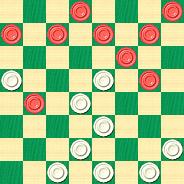
WHITE
White to Play and Win
W:W13,15,18,23,26,28,30,31,32:B2,4,5,6,7,8,11,16,17.
Can you match Mr. Reed for brilliance and find the winning move? We'll warn you, it's really something and takes a truly skilled player to find. How about correcting Mr. Barker's "blunder" and instead demonstrating a draw?
Work it out and then click on Read More to see if your play really shines.![]()
Double Barreled Action

It's double barreled action in today's installment of Checker School, as we continue to bring you interesting situations from Boland's Famous Positions in the Game of Checkers.
Let's look at one that you might find challenging. It's by F. W. Drinkwater, and the solution contains a number of "star" moves. (A "star" move is a move for which there is no alternative, and it's often rather hard to spot.) Fire away!
WHITE
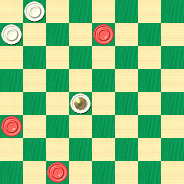
BLACK
Black to Play and Draw
B:W28,32,K15:B3,12,26.
If you missed the target on that one, prime the second barrel and try this easier position, which arises from a variant of the first problem's solution. It's credited to A. Sinclair.
BLACK
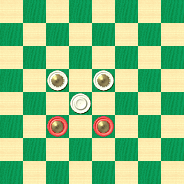
WHITE
Black to Play, White Wins
B:WK14,K15,18:BK22,K23.
No matter how well you've aimed, though, you won't get shot down. Trip the mouse trigger on Read More and score a bullseye with Ben Boland's solutions, illustrative game, and detailed notes.![]()
Uncle Ben's Porch

As I made my way down the sidewalk, a trace of early morning coolness still lingered in the air, but the temperature was on the rise and I knew that another hot and humid Florida day was ahead. But it was still, in every respect, a fine Saturday morning, a day free from school and a morning free of chores; and on many a Saturday morning such as this one I would make my way over to Uncle Ben's porch.
He would always be waiting for me there, usually with an ice-cold pitcher of fresh-made lemonade or sometimes sweet tea. And his checkerboard would be set up and ready.
It was no different this morning. I called out a greeting to him. "Mornin', Uncle Ben!" Of course, he wasn't really my Uncle, but we all called him that. We didn't know all that much about him, just that he had lived in the New York City area until his retirement, and that he was a famous checker expert who had written a lot of books.
"Mornin', Tommy," he replied. "Ready for a little checkers today?" Uncle Ben had that wry grin that told me he was expecting me this morning and that he was ready with something new to challenge me.
"Sure am", I answered as I climbed up the old stairs to the porch. Uncle Ben had been teaching me checkers and he told me I was making good progress. I thought so, too, judging by the number of games I was winning in the schoolyard, but then Uncle Ben would always encourage me to learn more and do better.
"What do you think of this one, Tommy?" he asked. I pulled up a chair and looked at the checkerboard. Uncle Ben had set up this position:
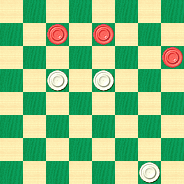
WHITE
White to Play and Win
W:W32,15,14:B6,7,12.
"Can you work it out, Tommy?" Uncle Ben inquired of me, "It isn't as hard as some others, you know!" Uncle Ben's idea of "hard" was a little different than mine, I can tell you, but I wasn't going to quit without giving it a good try.
Well, I sure had to spend a few minutes thinking. After a bit, Uncle Ben asked, "Would a glass of lemonade help?" He didn't wait for my reply but went ahead and poured me a tall, brimming-full glass of his delicious, cold lemonade. He always seemed to know just the right time to offer refreshments or give a hint. He was a natural-born teacher and I often wished my teachers at school had his ways.
I took a few sips, thought a little more, and suddenly the idea came to me. Another few moments and some additional mental effort convinced me that I was on the right track. Finally, I offered, "Yep, Uncle Ben, I think I'm ready."
"OK, then, young man, show me how it's done!" he exclaimed.
"Well, here's my idea," I said, as I started to shift the checkers.....
What solution would you have proposed to Uncle Ben? Unfortunately, you'll have to make your own lemonade, but when you're ready, click on Read More for the solution, commentary, a sample game, and over two dozen fully-diagrammed additional examples of this common and important checker theme.![]()
Labor Day Race

This article will be published on Labor Day weekend, a time to kick back, relax, enjoy a beverage, and recognize the ordinary working guy and gal; the people who through their daily hard work and perseverance make America great. We know that many of these folk are checker players, as checkers is the mind sport of the common man; and today we salute all of you with our September speed problems.
September Speed Problem 1 (easy enough but a bit odd; one minute)
September Speed Problem 2 (moderately easy; two minutes)![]()
The Twelve Move Sack

We continue to electronically reprint Willie Ryan's unmatched classic, Tricks Traps & Shots of the Checkerboard, in tantalizing monthly installments. This month, we feature a twelve move debacle and a thrilling triple action shot. Willie himself explains.
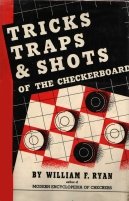
A Twelve-Move Sack
It takes only one bad move to make a total wreck out of a good healthy position, as the reader will note from a cursory examination of this well-known 12-move mop-up. White's play up to A is sound enough; but with 21-17, black cuts loose with a withering blast of fireworks. Proceed:
10-14 24-19 11-16 28-24 16-20 19-15 9-13 23-19 7-10 32-28 14-18 21-17---A, forming the diagram.
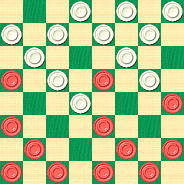
BLACK
Black to Play and Win
B:W15,17,19,22,24,25,26,27,28,29,30,31:B1,2,3,4,5,6,8,10,12,13,18,20.
A---This is where white misses the boat. The following is correct to draw: 26-23, 2-7, 23-14, 10-26, 30-23, 8-11, 15-8, 4-11, 31-26, 6-10, 19-16, 12-19, 24-6, 1-10, 26-22, 10-14, 22-17, 13-22, 25-9, 5-14, 29-25, 11-15, 25-22, 7-10, 22-17, 15-18, 17-13, 18-22, 13-9, 22-26, 9-6, 10-15, 6-2, 15-18. Wm. F. Ryan.
An Old Familiar
The following catch is well-known to all expert players, and is particularly useful in crossboard play, because it arises from several openings. In this example, a triple action shot does the trick, white executing three separate double jumps in succession.
9-13 23-19 6-9 27-23 9-14 22-18 11-15 18-11 8-15 23-18 14-23---A. See the diagram.
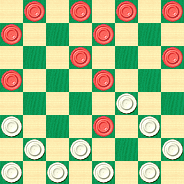
WHITE
White to Play and Win
W:W19,21,24,25,26,28,29,30,31,32:B1,2,3,4,5,7,10,12,13,15,23.
A---The wrong jump. The correct play is: 15-22, 25-9, 5-14, 19-16, 12-19, 24-6, 1-10, 29-25, 4-8, 25-22, 8-11, 28-24, 11-15, 32-27, 7-11, 26-23, 3-8, 30-26, 14-18, 23-7, 15-19, 24-15, 11-25, ending in a draw.
Don't get sacked yourself; clicking on Read More will bring you solutions and commentary.![]()
Fifty Years of Composing

Melyvn Green, of Salford, England, next year will celebrate 50 years of composing original stroke problems. Mr. Green has composed hundreds of these teasers in the course of a long creative career that started in 1957.
Draughts stroke problems, as we've noted here before, are not everyone's cup of tea, much as composed chess problems are not to every chess player's taste. But, fan or not (and we confess to being unabashed fans), stroke problems have their own ineffable charm and appeal, with their often complex layouts and devilishly concealed key moves. Melvyn calls them, "hidden beauty on a draughtsboard," and has published a book with that exact title, collecting together 138 of his best puzzlers, enough to keep even the most dedicated solver busy for months.
Here's one of Melvyn's newer efforts, composed this past spring (2006). He categorizes it as "easy." You may or may not agree. Give it your best effort and then click on Read More for the solution.
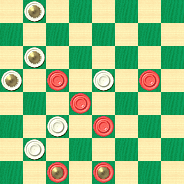
WHITE
White to Play and Win
W:WK1,K9,K13,15,22,25:B14,16,18,23,K30,K31.
To commemorate his 50th year of problem composition, Mr. Green is offering copies of his book for only US $5.00 postpaid. This price is so low that it barely covers international postage. The offer is good until the end of calendar year 2007. Don't miss this opportunity. The book is a true gem.
Mr. Green is a man of many interests, and has asked us to pass along the fascinating fact that he is also offering for sale a substantial part of his collection of fantasy, sci-fi, and horror movie magazines! He has, over the years, amassed a large number of these publications from the US, the UK, and other points abroad. If your own interests extend beyond draughts and into this area, you might wish to contact Melvyn.
Mr. Green can be reached by email at melcar@amserve.com, and by traditional postal mail at 8 Castlefield Avenue, Salford M7 4GQ, United Kingdom.![]()
Tupper-Ware

Checker School for this month presents a position and problem that a review of checker literature has shown to have been first published by C. W. Tupper rather than others who reprinted it later. Our own independent research efforts were unable to determine, however, if Mr. Tupper was in any way related to Earl S. Tupper (the son of Earnest and Lulu Tupper), the eventual inventor of Tupper-Ware. We have no reason at all to make such a connection other than pure speculation, of course, but the known dates and locations make this at least an interesting possibility. Is there such a thing as Tupper-Ware checkers? Perhaps this is a new marketing opportunity, and perhaps Marvin J. Mavin himself might endorse such a product.
BLACK

WHITE
White to Play and Draw
W:W8,K14,19:B3,12,K16.
Forces are even, but White will very soon be down a man. Can you store away a draw for the White forces, or will Black put a lid on things? When you've worked out your answers, click on Read More to uncover the solution.![]()
Dog Days of Summer

Our canine friend seems to have found a cool, wet place to seek relief from the heat of an August midafternoon. But if you wish to beat our relentless clock on this month's speed problems, you won't be able to rest on your haunches; you'll have to brave the heat and show some hustle.
August Speed Problem 1 (very easy to easy). We're allowing you all of 30 seconds for this one.
August Speed Problem 2 (easy to moderate). For this one, you get two minutes, though you may not need it.
But don't sweat; clicking on Read More will bring you cool comfort by showing you our solutions.![]()
The Zephyr

Today's problem, a Tom Wiswell gem provided to us by Harold Schneider, was titled Zephyr by Mr. Wiswell, though we're not sure quite why. After all, the word Zephyr has various meanings such as the west wind (after Zephyr, the Greek deity of the west wind); a gentle breeze; a soft, light fabric; or something airy, insubstantial, and passing.
Surely, though, there is nothing airy or insubstantial about our featured problem. Perhaps the title was inspired by the mighty passenger trains of a bygone day that took the name Zephyr. We really don't know; we simply invite you to partake of a cool summer refresher while basking in gentle westerly breezes, as you work out the solution to this challenger.
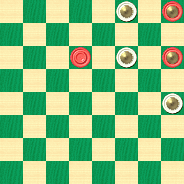
WHITE
White to Play and Win
W:WK20,K11,K3:BK12,10,K4.
It would seem that White's position is on the superior side and that the win should be rather easy. Appearances are often deceptive, though, and it will take your best efforts to bring about a White victory.
When you've come up with your answer, breeze on over and click Read More to see how it's done.![]()
The Checker Maven is produced at editorial offices in Honolulu, Hawai`i, as a completely non-commercial public service from which no income is obtained or sought. Original material is Copyright © 2004-2026 Avi Gobbler Publishing. Other material is public domain, AI generated, as attributed, or licensed under CC1, CC2, CC3 or CC4. Information presented on this site is offered as-is, at no cost, and bears no express or implied warranty as to accuracy or usability. You agree that you use such information entirely at your own risk. No liabilities of any kind under any legal theory whatsoever are accepted. The Checker Maven is dedicated to the memory of Mr. Bob Newell, Sr.

